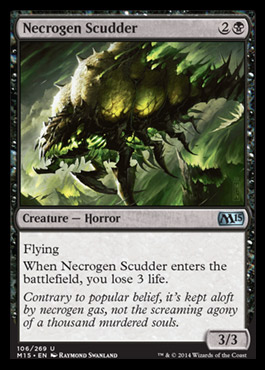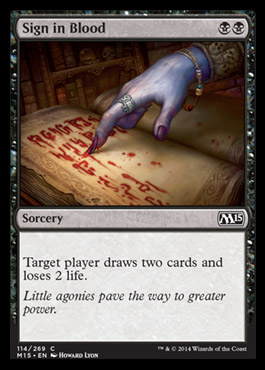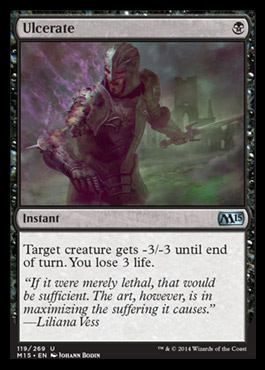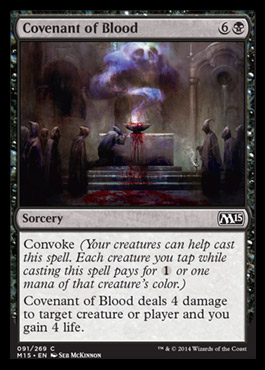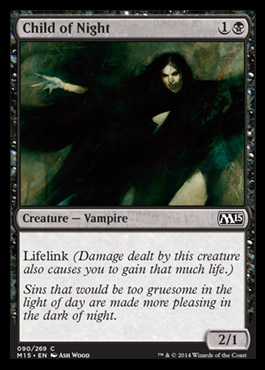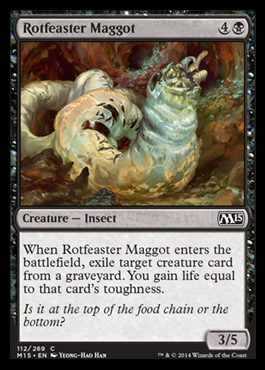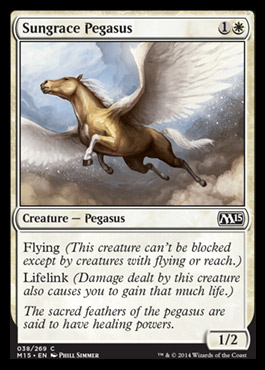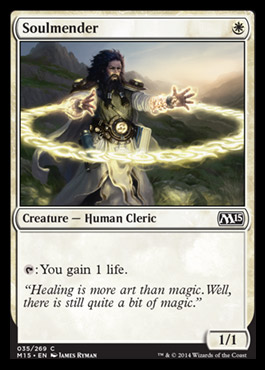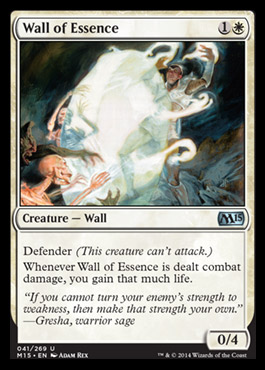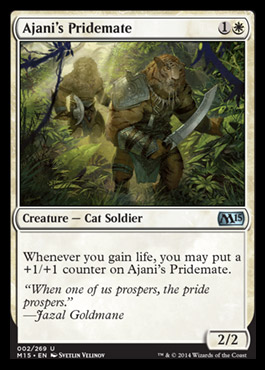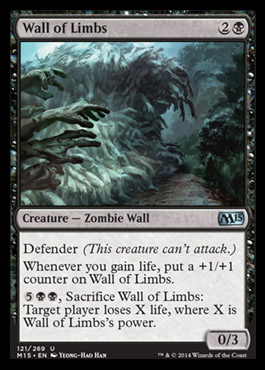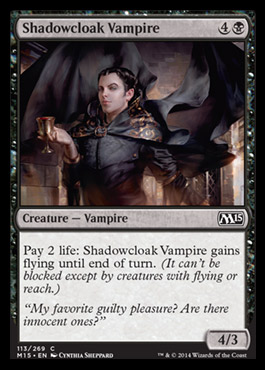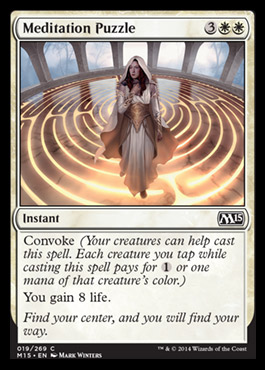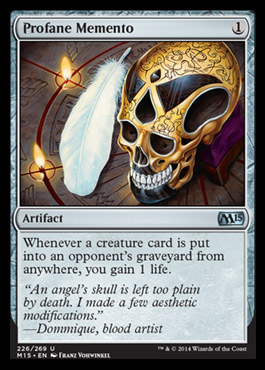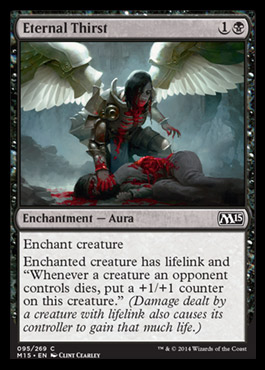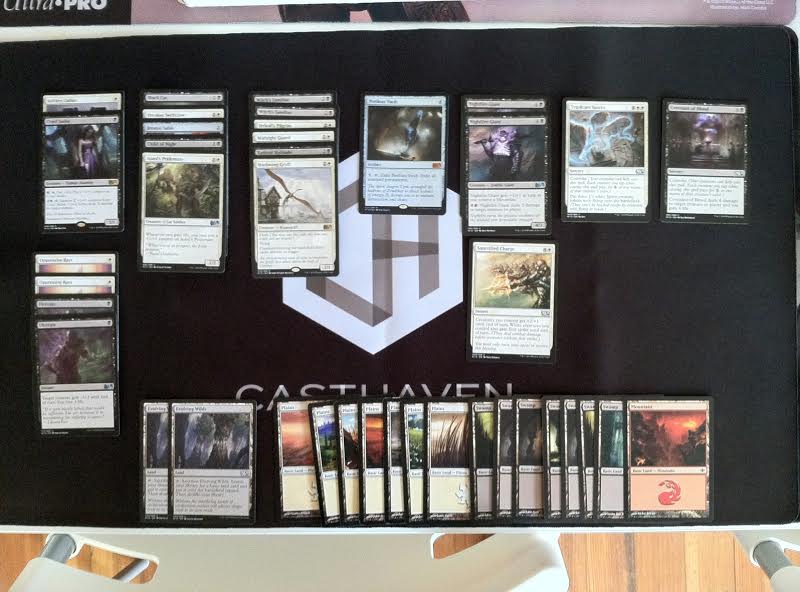I still haven’t figured out M15 as a draft format. Unlike most core sets, which lend themselves to being drafted on autopilot, M15 is, well…hard to draft. While perhaps it is agreed upon that white is the best color while blue, much to my chagrin, may be the worst, these color evaluations don’t strictly dictate the many potential archetypes and color combinations available in the format. Despite blue being kind of bad, blue-red tempo is one of the better archetypes in the format with a 55% win rate in the Pantheon house drafts right before the pro tour. Anyway, I wanted to spend some time today talking about a relatively under the radar strategy, black-white “life-matters,” as a potential archetype in the format.
First off, black-white is traditionally not a fantastic color combination in core sets because of the color intensive mana requirements of the cards. It feels really awkward to be playing stuff like Armored Warhorse, Ajani’s Sunstriker, and Blessing alongside cards like Quag Sickness, Sign in Blood, and Sorin’s Thirst. However, in M15 there are only two commons and three uncommons in white and black that cost more than a single color of mana. Furthermore, some of the double mana costs are alleviated by the fact that they have convoke, both Triplicate Spirits and Endless Obedience aren’t difficult to cast in the event that you have one creature of that color already in play.
The thing about black in M15 is that a lot of cards want to you to pay life. Necrogen Scudder, Sign in Blood, and the premium removal spell Ulcerate can quickly deplete your life total and often become uncastable against the many aggro archetypes in the format.
One way to offset the life payment is by pairing these cards with cards that gain life. While black can gain life through Covenant of Blood, Child of Night, and Rotfeaster Maggot, white offers up several other options including Soulmender, Sungrace Pegasus, and Wall of Essence.
While traditionally most of these life gain cards would be considered garbage, M15 has several cards that incentivize gaining life and turn traditional underperfomers into solid roleplayer cards.
The two cards that really reward you for gaining life are Ajani’s Pridemate and Wall of Limbs.
Pairing either of these cards with Soulmender or Sungrace Pegaus creates a must deal with threat that quickly becomes out of range of most of the removal in the format. While both of these cards are uncommon, they aren’t super high picks on their own. In most decks Pridemate is a grizzly bear and Wall of Limbs is an overcosted wall, which means you have a good chance of picking up these cards late and an even better chance of picking up very late Soulmenders and Sungrace Pegasus. I also like that having access to lifegain means Shadowcloak Vampire goes from basically unplayable to a reasonable late pick-up.
For the record, there are plenty of lifegain cards that I think are still abysmal even if you have multiple Ajani’s Pridmate and Wall of Limbs. You still should never play Meditation Puzzle, Profane Memento, Eternal Thirst, or any Staff of the ______ Magus.
I drafted a version of this deck last night at Knight Moves in Brookline. It didn’t quite come together the way I had hoped but here is the list:
M15 BW Deck Take One
| Creatures (15) 1 Selfless Cathar 1 Cruel Sadist 1 Black Cat 1 Oreksos Swiftclaw 1 Bronze Sable 1 Child of Night 1 Ajani’s Pridemate 2 Witch’s Familiar 1 Heliod’s Pilgrim 1 Midnight Guard 1 Hushwing Griff 1 Carrion Crow 2 Nightfire Giant Spells (8) 2 Ulcerate 2 Oppressive Rays 1 Perilous Vault 1 Triplicate Spirits 1 Covenant of Blood 1 Sanctified Charge | Lands (17) 2 Evolving Wilds 1 Mountain 7 Swamps 7 Plains Sideboard (2) 1 Mind Rot 1 Festergloom |
Here is what I liked about the deck:
- The curve—While I was playing some unexciting stuff like Witch’s Familiar, I was able to win plenty of games just by curving out. 17 of my 23 spells cost three or less, and this isn’t counting Covenant of Blood or Triplicate Spirits which can often be cast off three or four lands.
- The aura package—In general, I’m not a big fan of Oppressive Rays, but I was fine playing the pair of them in this reasonably aggressive deck especially when I could search one up with Heliod’s Pilgrim.
- The splash—With two Evolving Wilds and one Mountain, I was happy playing the two Nightfire Giants I picked up very late in the draft. I love that this card is castable without the mountain, but really insane with it.
- Triplicate Spirits + Sanctified Charge—I have won many games with this, and have lost just as many to my opponents who did this. Triplicate Spirits is so gross.
- The removal—While I didn’t manage to pick up any Flesh to Dust or Stab Wounds, the double Ulcerate, Covenant, and the two Oppressive Rays were more than enough to allow me to keep the beats going.
- Perilous Vault—Not only is this one of the only board wipes in the format, but someone passed me a foil one.
Here’s the stuff I wasn’t so hot on:
- Cruel Sadist—I first picked this card out of an unexciting pack because I wanted to try playing with it. The fact that it was aggressively costed and at worst a kind of Chronomoton appealed to me. However in practice, I found that putting counters on it would often disrupt my curve, and it was so fragile that even if you got it going, it would often just get Lightning Strike-d.
- The lean lifegain package—While I did win a game off Child of Night and Ajani’s Pridemate, I wish I had additional ways to trigger the Pridemate or had been able to wheel Wall of Limbs and Soulmender which I assumed no one wanted.
- Black Cat—I would have never thought about touching this in Innistrad Limited, but I played it here for curve/Convoke considerations. It still felt really bad.
I ended up going 2-1 in my draft, beating UB Control, RG Beats, and losing in the finals to a very aggressive RW deck with multiple Lightning Strikes and Inferno Fists. As I mentioned before, I don’t think that my draft last night illustrated the power of the archetype, but did show that even when a plan doesn’t quite come together, having a good curve and a solid plan are often enough to get there.
I’m really loving Limited right now, so expect another Draft video or article on M15 for next week.
At age 15, while standing in a record store with his high school bandmates, Shawn Massak made the uncool decision to spend the last of his money on a 7th edition starter deck (the one with foil Thorn Elemental). Since that fateful day 11 years ago, Shawn has decorated rooms of his apartment with MTG posters, cosplayed as Jace, the Mindsculptor, and competes with LSV for the record of most islands played (lifetime). When he’s not playing Magic, Shawn works as a job coach for people with disabilities and plays guitar in an indie-pop band.

